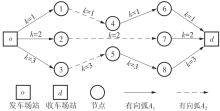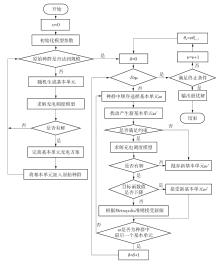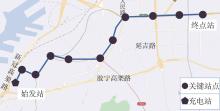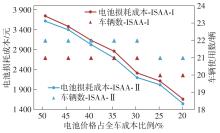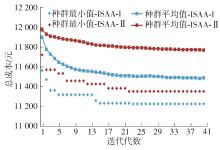Journal of South China University of Technology(Natural Science Edition) ›› 2023, Vol. 51 ›› Issue (10): 11-21.doi: 10.12141/j.issn.1000-565X.230279
Special Issue: 2023绿色智慧交通系统专辑
• Green, Intelligent Traffic System • Previous Articles Next Articles
Electric Bus Scheduling Method Considering Differences in the State of Health of Batteries
BIE Yiming ZHU Aoze CONG Yuan
- School of Transportation,Jilin University,Changchun 130022,Jilin,China
-
Received:2023-06-21Online:2023-10-25Published:2023-06-26 -
About author:别一鸣(1986-),男,博士,教授,主要从事城市公交运营研究。E-mail:yimingbie@126.com -
Supported by:the Excellent Talents (Team) Project of Young and Middle-aged Science and Technology Innovation and Entrepreneurship in Jilin Province(20230508048RC)
CLC Number:
Cite this article
BIE Yiming, ZHU Aoze, CONG Yuan. Electric Bus Scheduling Method Considering Differences in the State of Health of Batteries[J]. Journal of South China University of Technology(Natural Science Edition), 2023, 51(10): 11-21.
share this article
Table 5
Optimization results of vehicle scheduling plan under ISAA-I"
| 车辆编号 | 车辆调度计划 | 充电时间/min | ||
|---|---|---|---|---|
| 峰 | 谷 | 平 | ||
| 1 | 场站发车→24→38→55→75→104→返回场站 | 0 | 0 | 0 |
| 2 | 场站发车→12→30→49→69→92→111→返回场站 | 0 | 0 | 0 |
| 3 | 场站发车→2→充电→25→36→54→70→107→126→返回场站 | 0 | 10 | 0 |
| 4 | 场站发车→15→32→58→充电→80→101→132→返回场站 | 0 | 27 | 0 |
| 5 | 场站发车→16→43→62→充电→86→109→123→返回场站 | 0 | 30 | 0 |
| 6 | 场站发车→10→27→41→充电→83→97→110→131→返回场站 | 0 | 30 | 0 |
| 7 | 场站发车→6→充电→39→57→71→100→114→返回场站 | 0 | 10 | 0 |
| 8 | 场站发车→1→29→51→68→充电→88→102→124→130→返回场站 | 0 | 10 | 0 |
| 9 | 场站发车→9→35→64→90→106→120→返回场站 | 0 | 0 | 0 |
| 10 | 场站发车→8→充电→23→42→60→充电→76→89→13→119→返回场站 | 0;0 | 10;11 | 0;0 |
| 11 | 场站发车→19→48→72→113→返回场站 | 0 | 0 | 0 |
| 12 | 场站发车→7→充电→34→52→74→94→116→128→返回场站 | 0 | 10 | 0 |
| 13 | 场站发车→5→22→37→53→充电→81→98→122→返回场站 | 0 | 39 | 0 |
| 16 | 场站发车→3→21→40→61→78→91→返回场站 | 0 | 0 | 0 |
| 17 | 场站发车→11→26→66→85→112→121→129→返回场站 | 0 | 0 | 0 |
| 18 | 场站发车→13→56→73→87→125→返回场站 | 0 | 0 | 0 |
| 19 | 场站发车→14→31→50→充电→77→99→108→返回场站 | 0 | 17 | 0 |
| 20 | 场站发车→0→充电→28→45→63→79→95→105→返回场站 | 0 | 10 | 0 |
| 21 | 场站发车→20→44→59→充电→82→96→118→返回场站 | 0 | 30 | 0 |
| 22 | 场站发车→4→17→46→67→充电→93→115→127→返回场站 | 0 | 24 | 0 |
| 23 | 场站发车→18→33→47→65→84→117→返回场站 | 0 | 0 | 0 |
Table 7
Optimization results of vehicle scheduling plan under ISAA-Ⅱ"
| 车辆编号 | 车辆调度计划 | 充电时间/min | ||
|---|---|---|---|---|
| 峰 | 谷 | 平 | ||
| 1 | 场站发车→10→40→60→充电→82→100→114→返回场站 | 0 | 29 | 0 |
| 2 | 场站发车→5→23→32→48→75→122→返回场站 | 0 | 0 | 0 |
| 4 | 场站发车→16→41→64→充电→88→108→127→返回场站 | 0 | 29 | 0 |
| 5 | 场站发车→14→27→46→充电→84→99→110→返回场站 | 0 | 29 | 0 |
| 6 | 场站发车→11→50→68→充电→86→101→124→返回场站 | 0 | 19 | 0 |
| 7 | 场站发车→28→44→62→充电→78→105→121→返回场站 | 0 | 18 | 0 |
| 8 | 场站发车→6→充电→49→66→充电→85→96→119→返回场站 | 0;0 | 10;20 | 0;0 |
| 9 | 场站发车→18→33→53→充电→76→90→112→126→返回场站 | 0 | 11 | 0 |
| 10 | 场站发车→12→26→37→61→充电→79→93→125→返回场站 | 0 | 29 | 0 |
| 11 | 场站发车→4→19→36→58→73→87→113→返回场站 | 0 | 0 | 0 |
| 12 | 场站发车→7→21→42→72→95→129→返回场站 | 0 | 0 | 0 |
| 13 | 场站发车→22→34→52→67→115→返回场站 | 0 | 0 | 0 |
| 14 | 场站发车→30→45→59→充电→81→98→返回场站 | 0 | 29 | 0 |
| 15 | 场站发车→0→充电→15→38→56→充电→77→返回场站 | 0 | 10 | 0 |
| 16 | 场站发车→1→17→29→54→109→118→返回场站 | 0 | 0 | 0 |
| 17 | 场站发车→13→51→69→充电→89→106→返回场站 | 0 | 12 | 0 |
| 18 | 场站发车→20→39→55→71→94→111→返回场站 | 0 | 0 | 0 |
| 19 | 场站发车→3→24→35→57→充电→80→92→103→116→132→返回场站 | 0 | 35 | 0 |
| 20 | 场站发车→8→充电→74→107→117→128→返回场站 | 0 | 10 | 0 |
| 21 | 场站发车→31→64→91→131→返回场站 | 0 | 0 | 0 |
| 22 | 场站发车→9→43→63→充电→83→102→120→130→返回场站 | 0 | 29 | 0 |
| 23 | 场站发车→2→充电→25→47→70→97→104→123→返回场站 | 0 | 10 | 0 |
| 1 | WANG X, SONG Z, Xu H,et al .En-route fast charging infrastructure planning and scheduling for battery electric bus systems [J].Transportation Research Part D:Transport and Environment,2023,117:103659. |
| 2 | ROGGE M, EVELIEN V, LARSEN A,et al .Electric bus fleet size and mix problem with optimization of charging infrastructure [J].Applied Energy,2018,211:282-295. |
| 3 | ALWESABI Y, WANG Y, AVALOS R,et al .Electric bus scheduling under single depot dynamic wireless charging infrastructure planning [J].Energy,2020,213:118855. |
| 4 | 姚恩建,卢沐阳,刘宇环,等 .考虑充电约束的电动公交区域行车计划编制[J].华南理工大学学报(自然科学版),2019,47(9):68-73. |
| YAO Enjian, LU Muyang, LIU Yuhuan,et al .Electric bus area driving plan preparation considering charging constraints [J].Journal of South China University of Technology (Natural Science Edition),2019,47(9):68-73. | |
| 5 | ZHU C, CHEN X .Optimizing battery electric bus transit vehicle scheduling with battery exchanging:model and case study [J].Procedia Social and Behavioral Sciences, 2013,96:2725-2736. |
| 6 | YILDIRIM Ş, YILDIZ B .Electric bus fleet composition and scheduling [J].Transportation Research Part C:Emerging Technologies,2021,129:103197. |
| 7 | JI J, BIE Y, WANG L .Optimal electric bus fleet scheduling for a route with charging facility sharing [J].Transportation Research Part C:Emerging Technologies,2023,147:104010. |
| 8 | LIU K, GAO H, LIANG Z,et al .Optimal charging strategy for large-scale electric buses considering resource constraints [J].Transportation Research.Part D:Transport and Environment,2021,99:103009. |
| 9 | 唐春艳,杨凯强,邬娜 .单线纯电动公交车辆柔性调度优化[J].交通运输系统工程与信息,2020,20(3):156-162. |
| TANG Chun-yan, YANG Kai-qiang, WU Na .Optimizing flexible vehicle scheduling for single-line battery electric buses [J].Journal of Transportation Systems Engineering and Information Technology,2020,20(3):156-162. | |
| 10 | GKIOTSALITIS K, ILIOPOULOU C, KEPAPTSOGLOU K .An exact approach for the multi-depot electric bus scheduling problem with time windows [J].European Journal of Operational Research,2023,306(1):189-206. |
| 11 | TANG X, LIN X, HE F .Robust scheduling strategies of electric buses under stochastic traffic conditions [J].Transportation Research Part C:Emerging Technologies,2019,105:163-182. |
| 12 | VEPSÄLÄINEN J, RITARI A, LAJUNEN A,et al .Energy uncertainty analysis of electric buses [J].Energies,2018,11:3267. |
| 13 | LU T, YAO E, ZHANG Y,et al .Joint optimal scheduling for a mixed bus fleet under micro driving conditions [J].IEEE Transactions on Intelligent Transportation Systems,2021,22(4):2464-2475. |
| 14 | 巫威眺,林越,李余,等 .随机行程时间的电动公交调度模型[J].中国公路学报,2023,36(6):235-253. |
| WU Wei-tiao, LIN Yue, LI Yu,et al .The electric bus scheduling model with stochastic travel times [J].China Journal of High-way and Transport,2023,36(6):235-253. | |
| 15 | LIU K, GAO H, WANG Y,et al .2022.Robust charging strategies for electric bus fleets under energy consumption uncertainty [J].Transportation Research Part D:Transport and Environment,2022,104:103215. |
| 16 | WANG J, KANG L, LIU Y .Optimal scheduling for electric bus fleets based on dynamic programming approach by considering battery capacity fade [J].Renewable & Sustainable Energy Reviews,2020,130:109978. |
| 17 | 唐春艳,李小雨 .多车型纯电动公交车使用下的混合车队替换优化[J].交通运输系统工程与信息,2021,21(2):151-157. |
| TANG Chun-yan, LI Xiao-yu .Optimizing mixed transit fleet replacement with multi-type battery electric buses [J].Journal of Transportation Systems Engineering and Information Technology,2021,21(2):151-157. | |
| 18 | ZHANG L, ZENG Z, QU X .On the role of battery capacity fading mechanism in the lifecycle cost of electric bus fleet [J].IEEE Transactions on Intelligent Transportation Systems.2021,22(4):2371-2380. |
| 19 | LAM L, BAUER P .Practical capacity fading model for li-ion battery cells in electric vehicles [J].IEEE Transactions on Power Electronics,2013,28(12):5910-5918. |
| 20 | MA Z, FERREIRA L, MESBAH M,et al .Modeling bus travel time reliability with supply and demand data from automatic vehicle location and smart card systems [J].Transportation Research Record,2015,2533(1):17-27. |
| 21 | KOU W, CHEN X, YU L,et al .Urban commuters’ valuation of travel time reliability based on stated preference survey:A case study of Beijing [J].Transportation Research Part A:Policy and Practice,2017,95:372-380. |
| 22 | BIE Y, LIU Y, LI S,et al .HVAC operation planning for electric bus trips based on chance-constrained programming [J].Energy,2022,258:124807. |
| [1] | CHEN Yanyan, WANG Zifan, SUN Haodong, et al. Stuby on the Activity Patterns and Regularity of Public Transport Passengers [J]. Journal of South China University of Technology(Natural Science Edition), 2023, 51(8): 40-50. |
| [2] | ZHANG Wenhui, SU Jiaqi, HA Zihong, et al. Location and Capacity Optimization Model of Battery-Swapped Electric Bus Charging Station [J]. Journal of South China University of Technology(Natural Science Edition), 2023, 51(10): 126-134. |
| [3] | WENG Jiancheng, WANG Maolin, LIN Pengfei, et al. Cross-line Combined Bus Scheduling Optimization Method Based on Passenger Flow Characteristic Identification [J]. Journal of South China University of Technology(Natural Science Edition), 2022, 50(9): 39-48. |
| [4] | HAN Wanli, DU Bangshen, ZHAO Jianyou, et al. Optimization of Urban and Rural Public Transport Operation and Scheduling Considering Small Piece Express [J]. Journal of South China University of Technology (Natural Science Edition), 2021, 49(5): 28-37. |
| [5] | YAO Enjian LU Muyang LIU Yuhuan YUAN Ling. Electric Bus Area Driving Plan Preparation Considering Charging Constraints [J]. Journal of South China University of Technology(Natural Science Edition), 2019, 47(9): 68-73. |
| [6] | YAO Shushen WENG Xiaoxiong LI Feiyu. Analysis of Commuting Mode Based on Behavior Dynamics of Time Characteristics [J]. Journal of South China University of Technology(Natural Science Edition), 2019, 47(9): 53-60. |
| [7] | Wu Wei-tiao Jin Wen-zhou Wei Ming Sun De-qiang. Mixed Scheduling Model of Single-Line Bus for Zonal Vehicles [J]. Journal of South China University of Technology(Natural Science Edition), 2012, 40(11): 147-154. |
| [8] | Xu Jian-min Shou Yan-fang Lu Kai. Area Coordinated Control of Traffic Signals Based on Bi-Level Programming Model [J]. Journal of South China University of Technology (Natural Science Edition), 2011, 39(3): 95-100,106. |
| [9] | Chen Yao-jun Yao Xi-fan Zhang Qing. An Entropy-Based Hybrid Genetic Algorithm for Job-Shop Scheduling [J]. Journal of South China University of Technology (Natural Science Edition), 2009, 37(9): 112-116. |
| [10] | Xu Lin Wu Xiao-ming Zhang Yan-ru Yuan Heng-xin. Optimization of External Force of AEI-Cardiopulmonary Resuscitation Based on Simulated Annealing Algorithm [J]. Journal of South China University of Technology (Natural Science Edition), 2009, 37(12): 95-99. |
| [11] | Liu Wei-ming Huang Ya-fei . Combined Optimization Model and Algorithm of Toll Location and Toll Rate for Highway Network [J]. Journal of South China University of Technology (Natural Science Edition), 2008, 36(6): 78-83,94. |
| [12] | Gong Xiao-lan Wei Zhong-hua. Simulation of Ground Public Transportation Organization for Large-Scale Public Activity [J]. Journal of South China University of Technology (Natural Science Edition), 2008, 36(10): 51-56. |
| [13] | Shen Xian-jun Yang Jin-cai Ying Wei-qin Zheng Bo-jin Li Yuan-xiang. Adaptive General Particle Swarm Optimization for One-Dimension Cutting Stock Problem [J]. Journal of South China University of Technology (Natural Science Edition), 2007, 35(9): 113-117. |
| [14] | Zou Liang Xu Jian-min. Description and Guidance M odel Design of Public Transportation Networks [J]. Journal of South China University of Technology (Natural Science Edition), 2005, 33(9): 41-44. |
| Viewed | ||||||
|
Full text |
|
|||||
|
Abstract |
|
|||||
